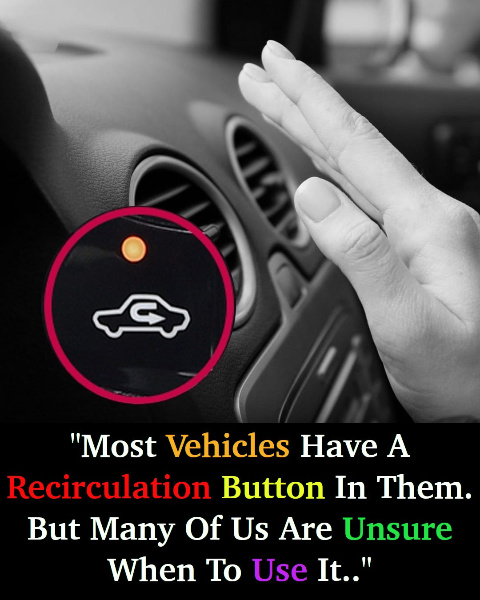Modern cars come packed with various features designed to enhance comfort, efficiency, and safety. One often-overlooked feature is the air recirculation button. Though it may seem minor compared to your heating or air conditioning controls, understanding how this button works and when to use it can greatly improve your driving experience.

What Is the Air Recirculation Button and How Does It Work?
The air recirculation button, typically symbolized by a car with a circular arrow, has a simple but important function: it prevents outside air from entering the vehicle and recirculates the air already inside the cabin. When activated, the system stops pulling in fresh air from outside and instead reuses the air within the car.
This is especially helpful for quickly cooling the cabin on a hot day. By circulating pre-cooled air, the air conditioning system doesn’t need to work as hard, making the process more efficient. It’s a small but powerful feature that can make a big difference in maintaining a comfortable temperature and improving air quality inside your vehicle.
The Benefits of Using the Air Recirculation Button
The air recirculation button isn’t just useful in summer—it has several advantages that go beyond temperature control. Let’s explore how it can enhance your driving experience.
1. Improved Fuel Efficiency
One of the key benefits of using the air recirculation button is increased fuel efficiency. By recirculating already cooled air, your car’s air conditioning system doesn’t need to cool hot air from outside repeatedly. This reduces the strain on the AC, allowing the engine to use less fuel. According to The Wall Street Journal, using this feature can lead to measurable fuel savings, especially during long drives in hot weather.
2. Cleaner Air Inside the Cabin
When driving in urban areas or heavy traffic, the outside air is often filled with exhaust fumes, dust, and other pollutants. By turning on the recirculation mode, you can keep these contaminants out of your car and circulate the cleaner air inside. This creates a healthier environment for you and your passengers, particularly for those with respiratory issues or allergies. Experts recommend using this feature when driving through industrial areas or in periods of high pollution to minimize exposure to harmful particles.
3. Faster Cooling on Hot Days
Nothing beats stepping into a cool car on a scorching day, and the air recirculation button can help you achieve that more quickly. By keeping the already cooled air inside the cabin, your air conditioning system can reach the desired temperature faster. This is especially useful in extreme heat, where pulling in hot air from outside would slow the cooling process and make your AC work harder.
When to Use the Air Recirculation Button
While the air recirculation button offers many advantages, knowing when to use it is key to getting the most out of this feature. Here are a few situations where the air recirculation button can enhance your comfort:
1. During Hot Weather
In summer or hot climates, using the air recirculation button allows your AC to cool the cabin more efficiently by reusing air that has already been chilled. Instead of constantly cooling hot air from outside, your system will cool the car more quickly, providing a comfortable ride in no time.
2. In Polluted Areas
If you’re driving in a city or an industrial zone with poor air quality, switching to recirculation mode can prevent polluted air from entering your vehicle. This is especially important if you or your passengers have allergies or respiratory conditions. By keeping the outdoor air out, you reduce the risk of breathing in harmful pollutants, making the ride healthier and more pleasant.
3. To Block Unpleasant Odors
If you find yourself driving past a landfill, a farm, or any other source of strong odors, the air recirculation button can keep those smells from getting inside your car. It traps the fresh air already in the cabin and blocks out unpleasant external odors, making your ride more enjoyable.
When Not to Use the Air Recirculation Button
While recirculation mode is useful in many situations, there are times when it’s best to avoid using it. Here are a few instances where turning off the recirculation mode is recommended:
1. In Cold or Humid Weather
Using the air recirculation mode in cold or humid weather can cause the windows to fog up due to increased moisture inside the cabin. Since recirculating the same air raises humidity levels, it’s better to switch to fresh air mode in these conditions to prevent fogging and maintain clear visibility.
2. On Long Drives
When driving for extended periods, keeping the air recirculation mode on for too long can cause carbon dioxide levels to build up inside the vehicle, making the air feel stale. Periodically switching to fresh air mode allows new, oxygen-rich air to enter, preventing discomfort during long trips.
3. For Passengers with Respiratory Concerns
While recirculation mode keeps outdoor pollutants at bay, it may not be ideal for people with respiratory conditions. If someone in the car has sensitivities related to indoor air quality, switching to fresh air mode can bring in cleaner, filtered outdoor air, improving overall comfort.
Conclusion: Making the Most of the Air Recirculation Button
The air recirculation button is a simple yet powerful tool that can significantly enhance your driving experience. Whether you’re looking to cool your car faster, block out pollution, or avoid unpleasant odors, this button can help make your ride more comfortable and efficient.
By knowing when and how to use the air recirculation mode, you can take control of your vehicle’s air quality and enjoy a cleaner, cooler, and more pleasant ride. So next time you’re driving, don’t underestimate the power of this button—it might just be the key to a better trip!





